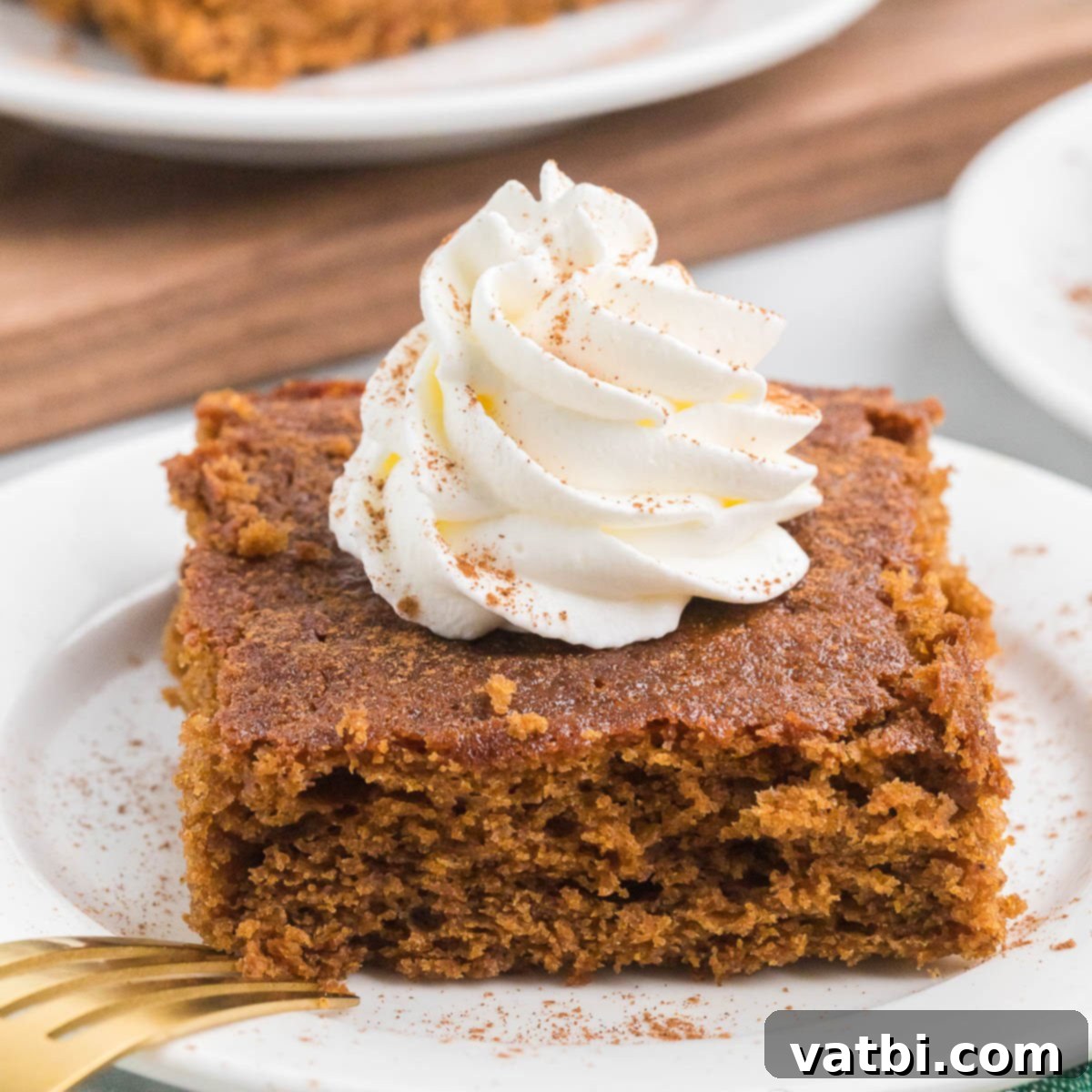The Ultimate Moist Gingerbread Cake Recipe: A Festive Holiday Delight
There’s nothing quite like the warm, inviting aroma of gingerbread to signal the start of the holiday season. This **super moist gingerbread cake recipe** is an absolute classic, designed to bring joy and festive cheer to any gathering. Forget dry, crumbly cakes – our old-fashioned recipe guarantees a tender, flavorful, and incredibly moist gingerbread experience that will quickly become a cherished tradition. Perfect as a cozy snack, a decadent dessert, or a delightful accompaniment to your morning coffee, this cake is surprisingly easy to prepare, making it ideal for busy holiday schedules.
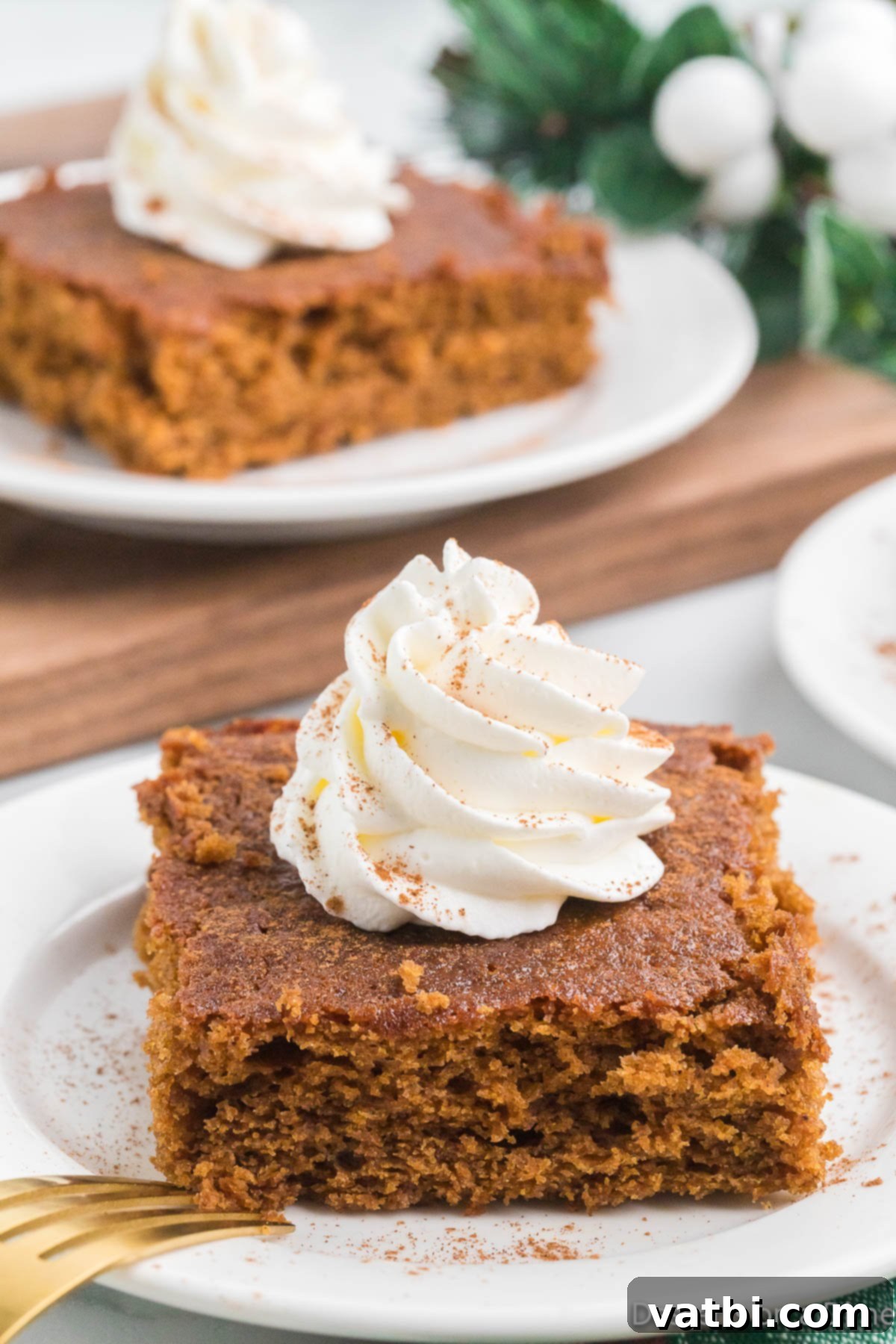
Gingerbread evokes memories of festive traditions, from intricately decorated gingerbread houses to delicious soft gingerbread cookies and rich Ginger Molasses Cookies. This cake captures all those beloved flavors in one glorious dessert. The harmonious blend of pungent ginger, warm cinnamon, aromatic nutmeg, and a hint of cloves creates a truly unforgettable taste profile. Beyond this delightful cake, be sure to explore our extensive collection of Christmas Dessert Recipes to complete your holiday baking repertoire. And for an extra fun activity, why not try making a Gingerbread House?
Table of Contents: Homemade Gingerbread Cake
- Why You’ll Love This Gingerbread Cake:
- Gingerbread Cake vs. Ginger Cake: What’s the Difference?
- Essential Ingredients for Your Gingerbread Cake
- Simple Substitutions and Flavorful Additions:
- Easy Step-by-Step Instructions:
- Expert Baking Tips for the Perfect Cake:
- How to Frost Your Gingerbread Cake:
- Can You Make Gingerbread Cupcakes?
- Troubleshooting: Why is My Gingerbread Cake Dry?
- Freezing Gingerbread Cake for Future Enjoyment:
- Storing Your Gingerbread Cake to Keep it Fresh:
- More Easy and Delicious Cake Recipes:
- Gingerbread Cake Recipe Card
Why You’ll Love This Gingerbread Cake:
- The Ultimate Holiday Indulgence – This gingerbread cake isn’t just a dessert; it’s an experience. Each bite offers a perfect balance of warmth and sweetness, with a soft, tender crumb that melts in your mouth. Its rich, spiced flavor profile makes it the quintessential centerpiece for any festive celebration or a comforting treat on a cold winter’s day. It truly embodies the spirit of the holidays in every slice.
- Effortlessly Easy to Prepare – Despite its impressive flavor and texture, this cake is remarkably simple to make. With a preparation time of less than 15 minutes, it’s the perfect solution when you need a show-stopping dessert without spending hours in the kitchen. Whether you’re a seasoned baker or new to the craft, you’ll find this recipe straightforward and rewarding.
- Versatile Topping Options – The cake itself is so packed with flavor that it can be served beautifully on its own, perhaps with a simple dusting of powdered sugar for an elegant touch. However, for those who love a little extra decadence, it pairs wonderfully with a light whipped cream or a rich cream cheese frosting, allowing for customization based on your preference.
- Perfect for Any Occasion – This gingerbread cake is incredibly versatile. Enjoy a slice as a delightful afternoon snack, a satisfying dessert after a holiday meal, or even as a special treat alongside your morning coffee or tea. Its comforting flavors make it suitable for a wide range of moments, big or small, throughout the festive season.
Gingerbread Cake vs. Ginger Cake: What’s the Difference?
While often used interchangeably, “gingerbread cake” and “ginger cake” typically refer to slightly different desserts, primarily due to their ingredient profiles and resulting flavor complexities. An **old-fashioned gingerbread recipe**, like the one we’re sharing, is characterized by a rich blend of warm, ground spices, most notably ginger, cinnamon, and cloves, often complemented by nutmeg. The defining ingredient, however, is molasses. Molasses not only imparts a deep, distinctive flavor and a beautiful dark hue but also contributes significantly to the cake’s characteristic moisture and dense, chewy texture.
In contrast, a standard **ginger cake** relies predominantly on ginger spice for its flavor and usually omits molasses. This often results in a lighter-colored, less intensely spiced cake with a generally less complex flavor profile and a texture that might be more akin to a traditional sponge cake. Our gingerbread cake embraces the full spectrum of holiday spices and the deep, rich notes of molasses, making it a truly authentic and flavorful holiday treat.
Essential Ingredients for Your Gingerbread Cake
Crafting this delicious gingerbread cake requires a few pantry staples and a generous hand with warming spices. Each ingredient plays a crucial role in achieving the perfect balance of flavor, moisture, and texture. Here’s what you’ll need to gather:
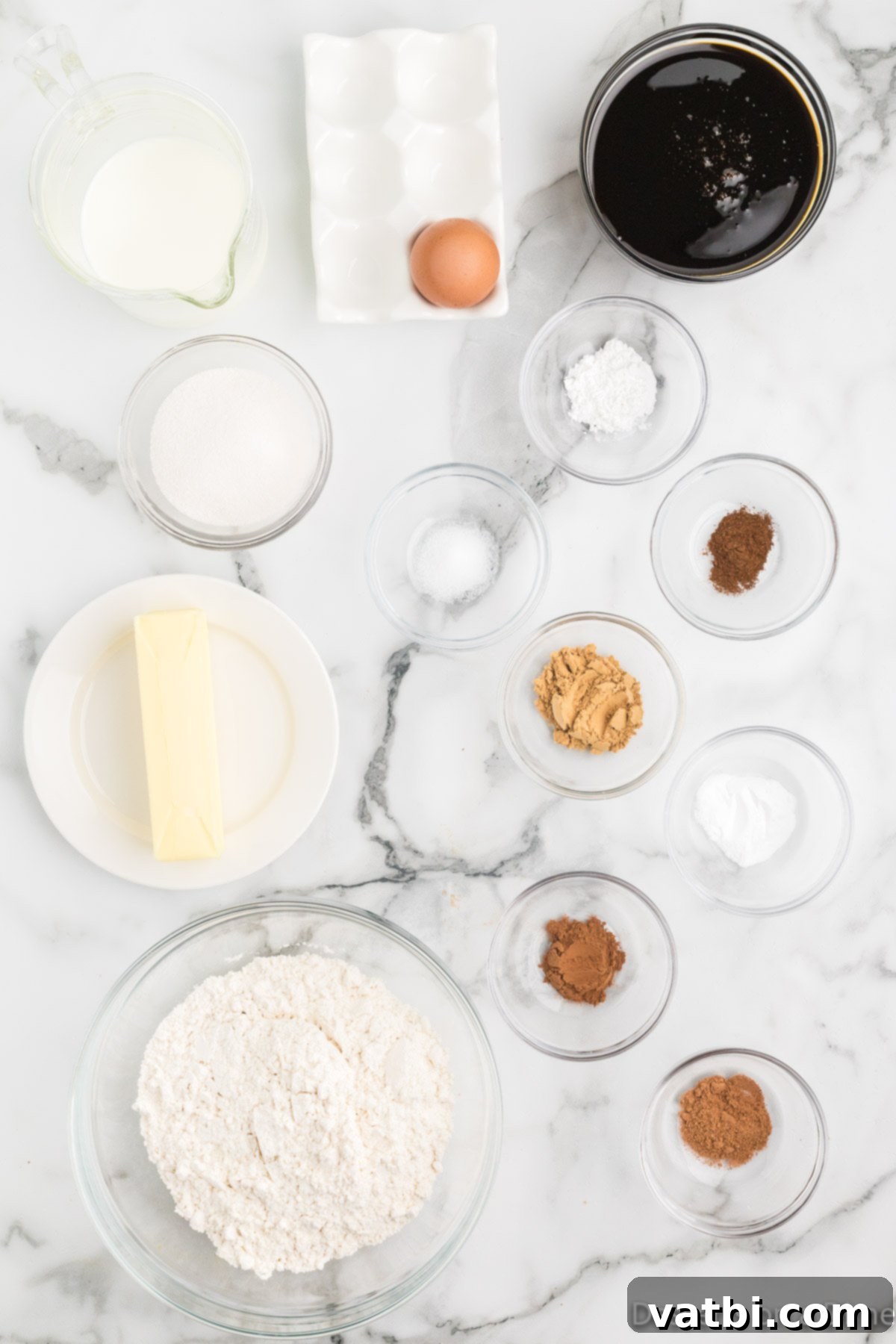
- All-purpose Flour: The structural base of our cake, providing tender support.
- Baking Powder & Baking Soda: These leavening agents work together with the buttermilk and molasses to give the cake its lift and soft crumb.
- Salt: A pinch of salt enhances all the other flavors, balancing the sweetness and spice.
- Ground Ginger: The star spice, delivering that signature warm, slightly peppery kick.
- Ground Cinnamon: Adds warmth and a sweet, woody aroma that complements the ginger.
- Ground Nutmeg: Offers a delicate, earthy, and slightly sweet spice note.
- Ground Cloves: Provides a deep, intensely aromatic, and slightly pungent flavor that completes the gingerbread spice blend.
- Unsalted Butter, softened: Crucial for richness and a tender texture. Ensure it’s softened to cream properly with sugar.
- Molasses: The key to the cake’s deep color, distinctive flavor, and incredible moisture.
- Granulated Sugar: Sweetens the cake and helps achieve a fine crumb when creamed with butter.
- Large Egg, room temperature: Binds the ingredients and adds richness. Room temperature eggs emulsify better with other ingredients.
- Buttermilk: Adds tang, moisture, and activates the baking soda, contributing to a wonderfully tender texture. Learn more about What is Buttermilk and its uses.
- Whipped Cream for serving (if desired): A light, airy counterpoint to the rich cake.
- Powdered Sugar, for dusting (if desired): A simple yet elegant garnish.
For the precise measurements and a detailed step-by-step recipe, please scroll down to the full recipe card at the bottom of this post.
Simple Substitutions and Flavorful Additions:
This gingerbread cake recipe is wonderfully adaptable, allowing you to customize it to your taste or dietary needs. Here are some fantastic ways to enhance or modify your holiday gingerbread cake:
- Add a Nutty Crunch – Introducing nuts can provide a delightful textural contrast and an extra layer of flavor. Try incorporating about ½ to 1 cup of chopped walnuts, pecans, almonds, or cashews into the batter. For an elegant finish, you can also sprinkle chopped nuts over the top of the cake before or after baking, especially if serving with a simple dusting of powdered sugar or a dollop of whipped cream.
- Make it Gluten-Free – If you’re looking for a gluten-free option, this recipe can easily be adapted. Simply substitute the all-purpose flour with a high-quality 1:1 gluten-free baking flour blend. Most 1:1 blends are designed to perform similarly to wheat flour, ensuring your cake retains its delicious texture and moisture. Always check the specific recommendations for your chosen GF flour blend.
- Stir in Dried Fruit for Extra Zest – For a lovely twist on this classic holiday cake, consider mixing in about ½ to 1 cup of dried fruit. Finely diced dried apples, cranberries, golden raisins, candied orange peel, or even small pieces of dried pineapple can add bursts of fruity flavor and chewiness that beautifully complement the spices. Soak firmer dried fruits in a little warm water or rum for 10-15 minutes before adding to plump them up.
- Experiment with Brown Sugar – While our recipe calls for granulated sugar, using brown sugar can deepen the molasses flavor and add even more moisture to the cake. You can substitute all or part of the granulated sugar with light or dark brown sugar, depending on how rich and moist you prefer your cake. Dark brown sugar will impart a more intense caramel and molasses flavor.
Easy Step-by-Step Instructions:
Making this moist gingerbread cake is a straightforward process. Follow these steps for a perfect holiday treat every time:
- Step 1: Prepare Your Oven and Pan – Begin by preheating your oven to 350 degrees F (175 degrees C). This ensures the oven is at the correct temperature when your batter is ready, promoting even baking. Next, prepare a 13×9-inch baking pan by lightly greasing it with cooking spray and then dusting it with a thin layer of flour. This crucial step prevents sticking and helps the cake release cleanly after baking.
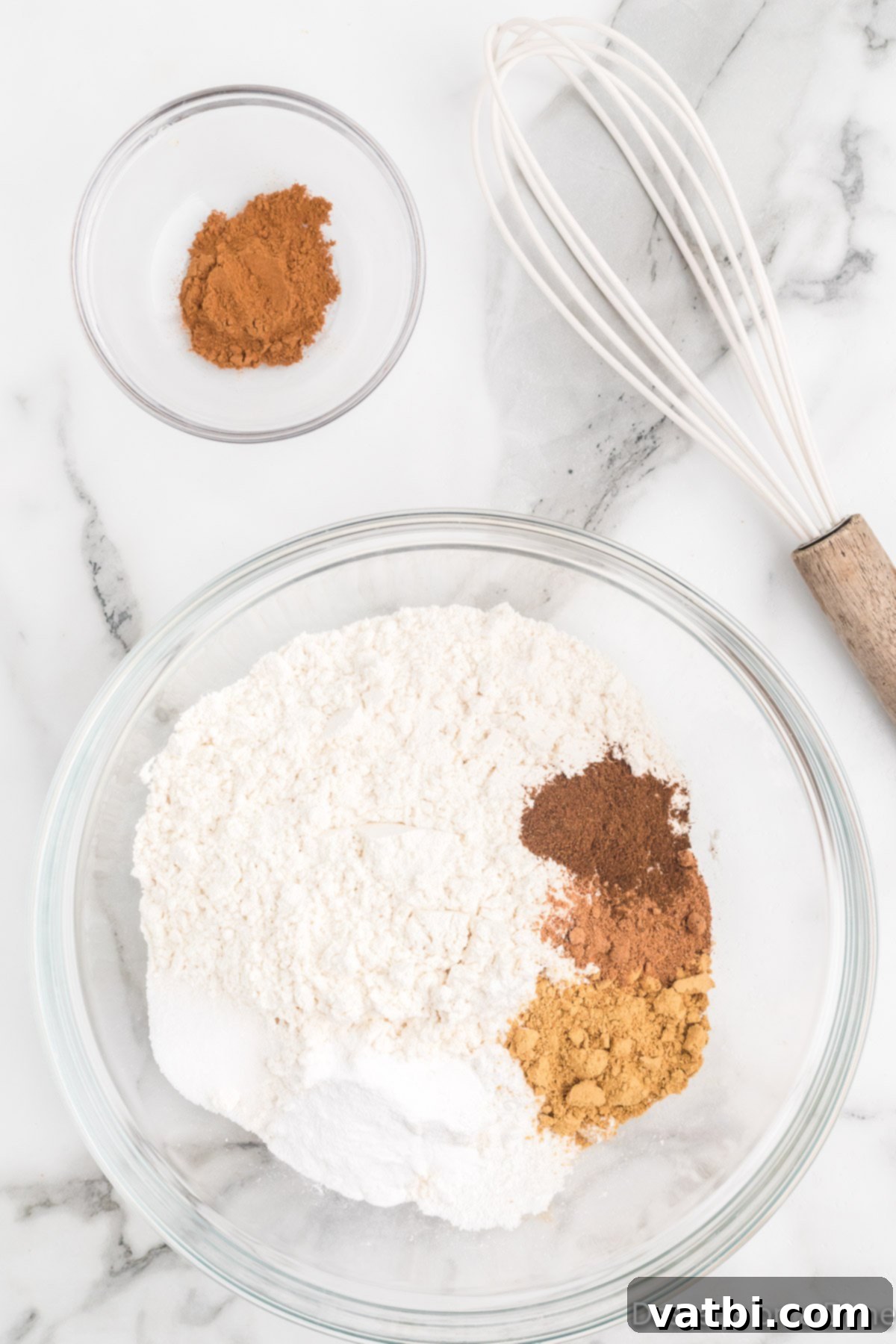
Step 2: Combine Dry Ingredients – In a medium-sized bowl, whisk together the all-purpose flour, baking soda, baking powder, salt, ground ginger, ground cinnamon, ground nutmeg, and ground cloves. Ensure these dry ingredients are thoroughly combined and evenly distributed. This step prevents clumps and ensures a consistent rise and flavor throughout the cake.
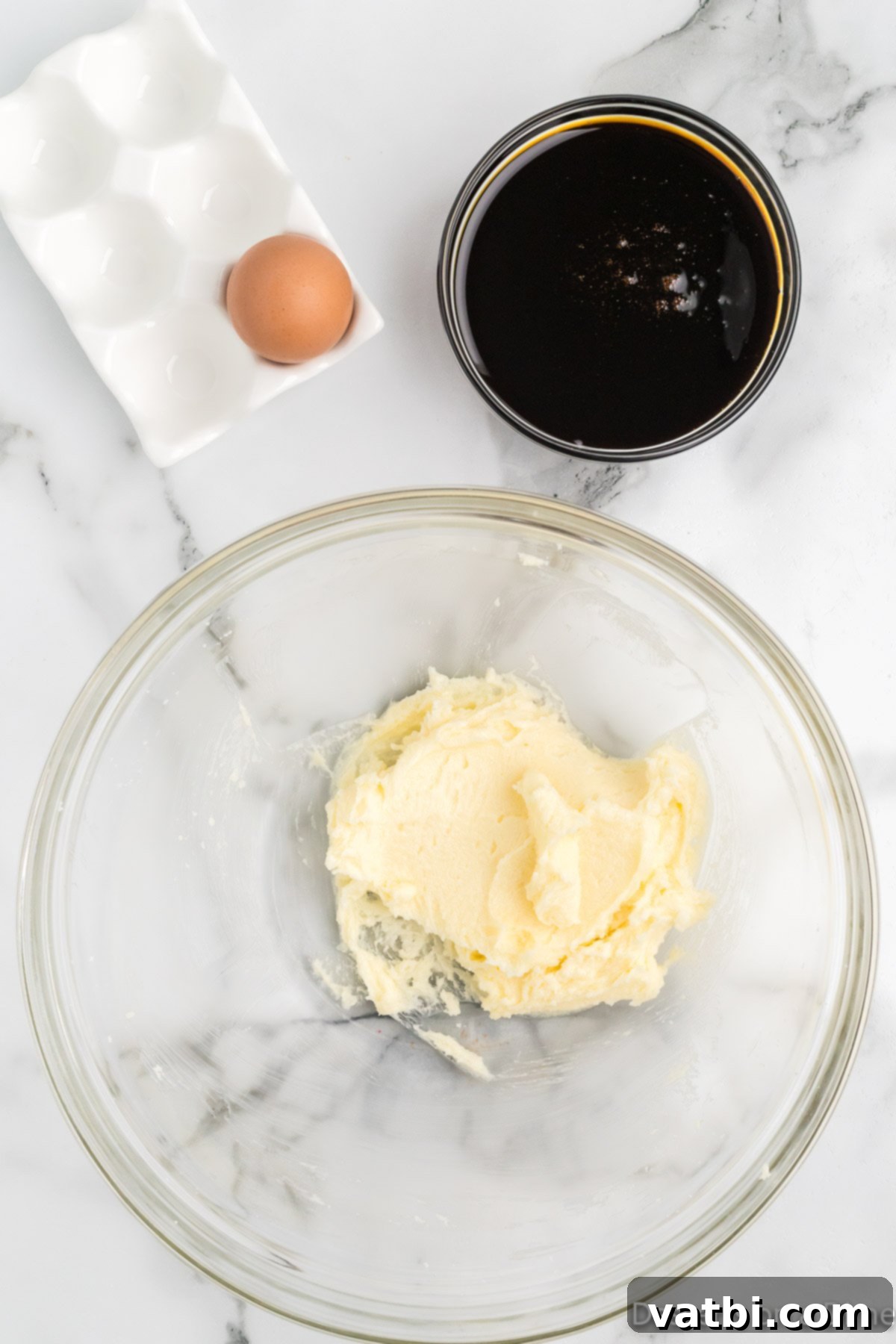
Step 3: Cream Wet Ingredients – In a large mixing bowl, using an electric mixer, cream together the softened unsalted butter and granulated sugar until the mixture is light and fluffy. This process incorporates air, contributing to the cake’s tender crumb. Next, beat in the large egg and molasses until well combined. The mixture might look slightly curdled at first but will come together as you continue mixing.
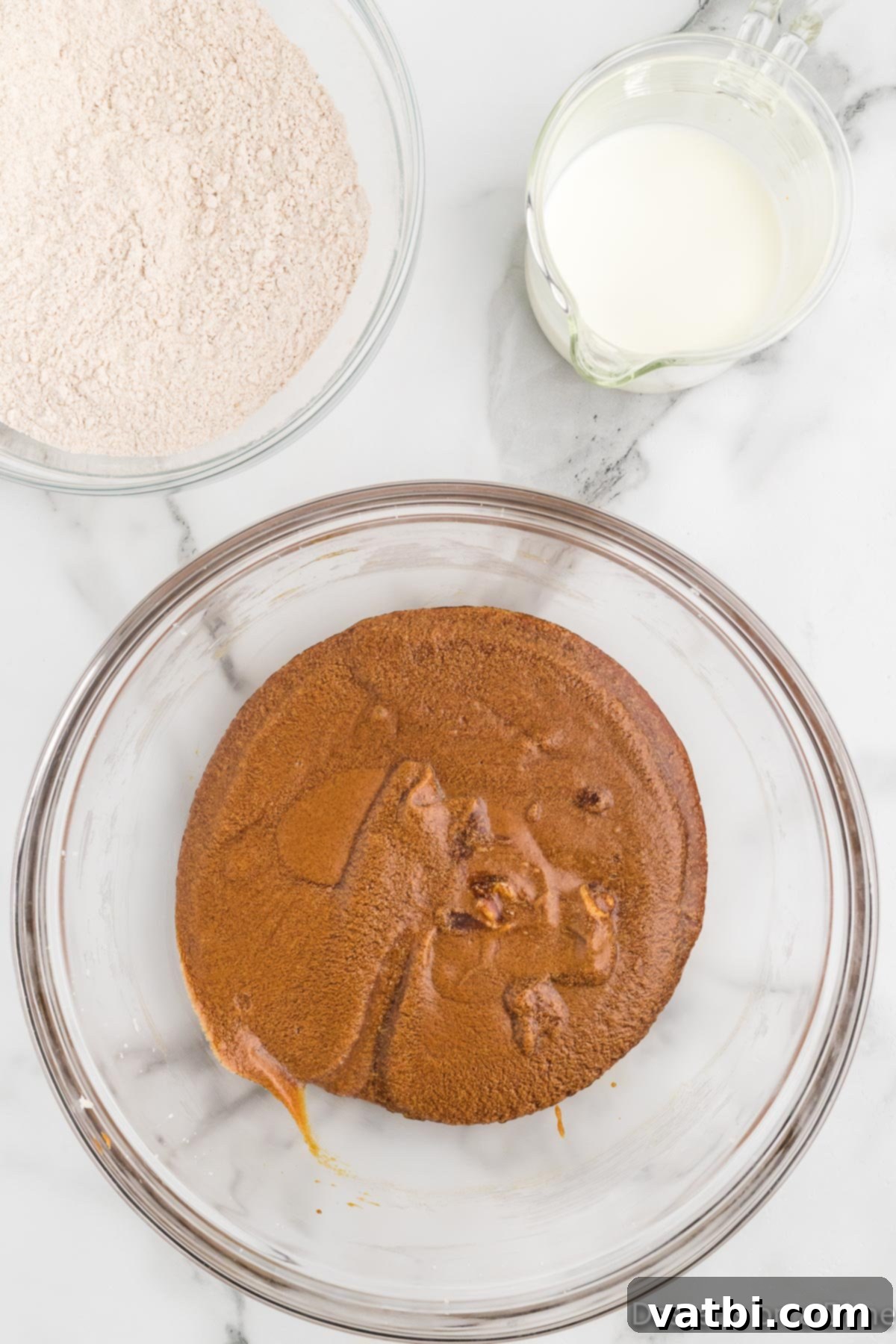
Step 4: Combine Wet and Dry – Gradually add the dry ingredient mixture to the wet ingredients, alternating with the buttermilk. Begin and end with the dry ingredients. Beat gently after each addition, just until combined, being careful not to overmix. Use a spatula to scrape down the sides and bottom of the bowl periodically to ensure all ingredients are fully incorporated. Overmixing can lead to a tough cake.

Step 5: Bake to Perfection – Pour and spread the finished batter evenly into your prepared 13×9-inch baking pan. Bake for approximately 40-45 minutes, or until a wooden toothpick inserted into the center of the cake comes out clean. Keep in mind that baking times can vary slightly depending on your oven, so always rely on the toothpick test. Once baked, allow the cake to cool on a wire rack in the pan for about 10-15 minutes before inverting it onto the rack to cool completely. This moist gingerbread cake can also be adapted for a bundt pan, though baking time may need adjustment.
Expert Baking Tips for the Perfect Cake:
Achieving a truly exceptional gingerbread cake involves a few key practices. These expert tips will help ensure your cake is perfectly moist, flavorful, and a delight to serve:
- Customizing Spice Levels – The beauty of homemade gingerbread lies in its adaptability. The recipe provides a recommended amount of spices for a well-balanced flavor, but don’t hesitate to adjust them to your preference. If you prefer a bolder, spicier cake with a more pronounced kick, feel free to increase the amounts of ground ginger, cinnamon, or cloves. A little extra nutmeg can also enhance the overall warmth. Conversely, if you like a milder spice profile, you can slightly reduce them.
- Avoid Overbaking for Ultimate Moisture – Overbaking is the quickest way to end up with a dry cake. To check for doneness, gently insert a wooden toothpick or a thin skewer into the center of the cake. If it comes out clean or with only a few moist crumbs attached, your cake is ready. If you see wet batter, continue baking in short intervals (2-3 minutes) and retest. Remember, residual heat will continue to cook the cake slightly after it’s removed from the oven, so it’s better to slightly underbake than to overbake.
- Choosing Your Molasses – Molasses is a cornerstone of gingerbread flavor and moisture. You can use either regular (light) or dark (robust) molasses for this recipe. Regular molasses will give a milder, sweeter flavor, while dark molasses will provide a richer, more intense, and slightly less sweet profile, with a deeper color. Avoid blackstrap molasses, which is too bitter and strong for baking this type of cake. Your choice depends on how prominent you want the molasses flavor to be in the final product.
- The Importance of Room Temperature Ingredients – For the best results, ensure your butter and eggs are at room temperature before you begin mixing. Room temperature butter creams more easily with sugar, creating a light, airy foundation that traps air and contributes to the cake’s texture. Room temperature eggs also emulsify better with the fat in the batter, leading to a smoother, more uniform mixture and a finer, more tender crumb. Plan ahead by taking them out of the refrigerator an hour or two before you start baking.
- Don’t Overmix the Batter – Once you begin adding the dry ingredients and buttermilk, mix only until just combined. Overmixing develops the gluten in the flour, which can result in a tough, chewy cake rather than a tender, moist one. A few small streaks of flour are perfectly acceptable and will disappear during baking.
How to Frost Your Gingerbread Cake:
While this gingerbread cake is incredibly flavorful on its own, a simple topping can elevate it further. For a classic and easy presentation, we typically opt for a dusting of powdered sugar, which adds a delicate sweetness and an elegant finish. A generous dollop of homemade whipped cream is also a fantastic choice, providing a light, airy contrast to the rich, spiced cake.
However, if you’re in the mood for a more traditional and indulgent frosting, a creamy, tangy frosting is a perfect complement. Our favorite is a classic Cream Cheese Frosting Recipe. Made with just four simple ingredients, it’s incredibly easy to whip up and its smooth, slightly tart flavor beautifully balances the sweetness and warmth of the gingerbread. It’s truly one of the best homemade frosting options for this cake.
Can This Cake Be Made into Cupcakes?
Absolutely! This versatile gingerbread cake recipe can easily be adapted to make delicious individual cupcakes, perfect for portion control or for serving at parties. To convert the recipe:
- Prepare Your Muffin Pan: Line a standard muffin pan with cupcake liners, or generously spray each cup with nonstick cooking spray to prevent sticking.
- Fill the Liners: Fill each muffin cup about two-thirds full with the gingerbread cake batter. This allows room for the cupcakes to rise without overflowing.
- Adjust Baking Time: Bake the gingerbread cupcakes in your preheated oven at 350°F (175°C) for approximately 25-30 minutes. Keep a close eye on them, as baking times can vary. To check for doneness, insert a wooden toothpick into the center of a cupcake. If it comes out clean, they are ready.
Allow the cupcakes to cool in the pan for a few minutes before transferring them to a wire rack to cool completely. Once cooled, you can frost them with cream cheese frosting, dust them with powdered sugar, or top with whipped cream for a delightful treat.

Troubleshooting: Why is My Gingerbread Cake Dry?
A dry gingerbread cake can be disappointing, especially when you’re aiming for that signature moist, tender texture. Several factors can contribute to a dry cake, but most are easily preventable:
- Oven Temperature Issues: One of the most common culprits is an oven that runs too hot. An inaccurate oven temperature can cause the cake to bake too quickly and dry out before it’s fully cooked through. An oven thermometer is an inexpensive tool that can help you verify your oven’s true temperature. If your oven is consistently running hot, this could also be why a cake might sometimes sink in the middle, as the outside cooks too fast while the inside struggles to set.
- Overbaking: Even with a perfectly calibrated oven, baking the cake for too long will inevitably lead to dryness. Always rely on the toothpick test (as detailed in our expert tips) rather than just the recommended baking time, as oven performance varies.
- Too Much Flour: Precision in measuring ingredients, particularly flour, is essential. Adding too much flour can significantly alter the batter’s liquid-to-dry ratio, resulting in a dense, dry cake. Use a kitchen scale for accuracy, or if measuring by volume, spoon flour lightly into your measuring cup and level it off with a straight edge rather than scooping directly from the bag (which can compact it).
- Insufficient Liquid: Ensure all liquid ingredients, especially the buttermilk and molasses, are measured accurately. These are critical for the cake’s moistness.
- Overmixing: As mentioned in our expert tips, overmixing the batter after adding flour can develop the gluten, leading to a tough, dry texture. Mix just until the ingredients are combined.
By paying attention to these details, you can significantly reduce the risk of a dry cake and achieve a beautifully moist and tender gingerbread every time.
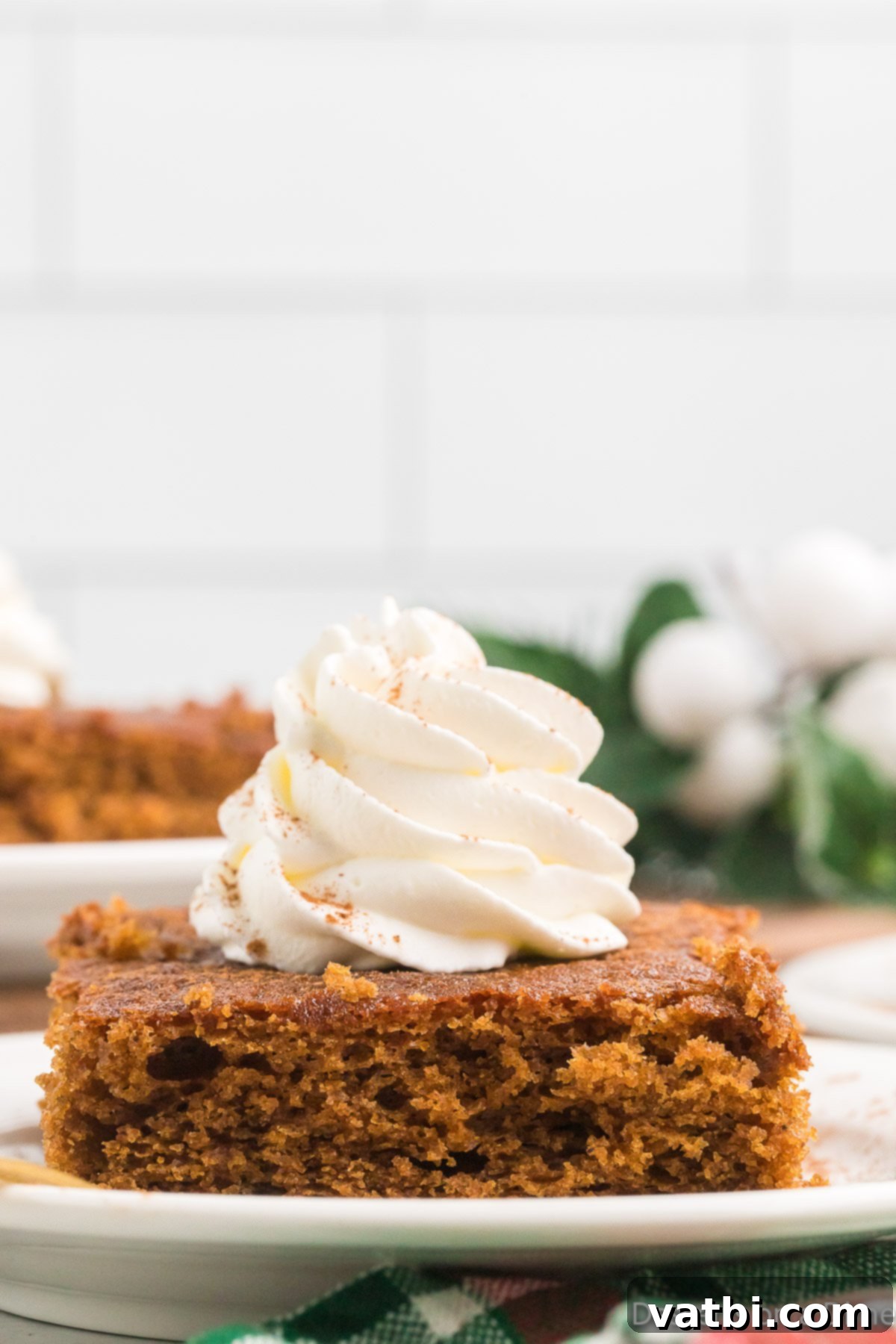
Freezing Gingerbread Cake for Future Enjoyment:
Yes, gingerbread cake freezes beautifully, making it an excellent dessert to prepare ahead of time, especially during the busy holiday season. Freezing allows you to enjoy a slice of festive cheer whenever the craving strikes or to have a ready-made dessert for unexpected guests.
- How to Freeze: Ensure the cake is completely cooled before freezing. For best results, wrap individual slices or the entire cake (if unfrosted) tightly in several layers of plastic wrap, then an additional layer of aluminum foil. This double layer helps prevent freezer burn and keeps the cake moist. Place the well-wrapped cake in a freezer-safe airtight container or a heavy-duty zip-top freezer bag.
- Storage Duration: Properly stored, gingerbread cake can last in the freezer for up to 2 months.
- Thawing: When you’re ready to enjoy, transfer the cake from the freezer to the refrigerator and let it thaw overnight. For a quicker thaw, you can leave individual slices at room temperature for a few hours. Once thawed, you can warm it slightly in the microwave or oven for that fresh-baked feel, then top with whipped cream or powdered sugar.
Making this cake in advance and freezing it is a fantastic way to manage your holiday baking schedule and ensures you always have a delightful treat on hand.
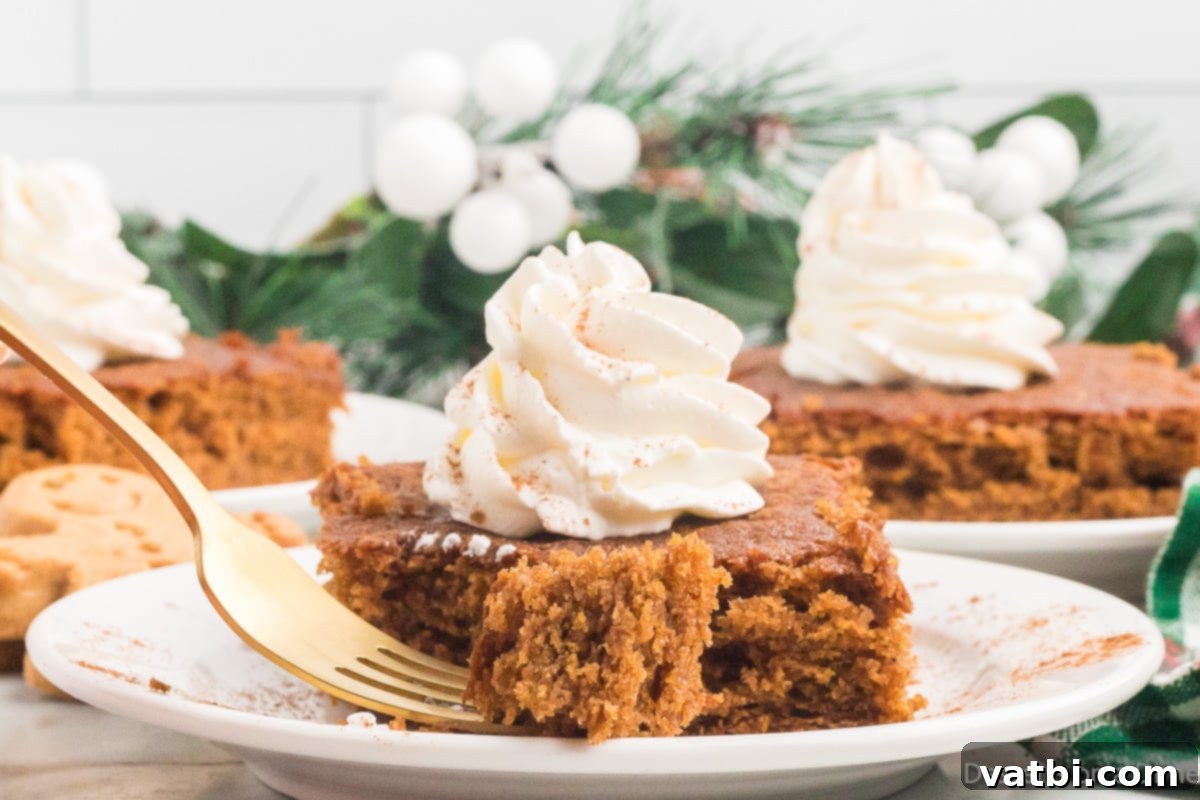
Storing Your Gingerbread Cake to Keep it Fresh:
To maintain the delightful moistness and rich flavor of your baked gingerbread cake, proper storage is key. We recommend storing the cake at room temperature for optimal enjoyment, especially within the first few days.
- Room Temperature Storage: Once the cake has cooled completely, cover it tightly with plastic wrap or place it in an airtight container. This protects it from air exposure, which can cause it to dry out. Stored this way, your gingerbread cake will remain fresh and wonderfully moist for up to 5 days. If it’s frosted with a perishable frosting like cream cheese frosting, it should be refrigerated.
- Refrigeration: If you need to store the cake for longer than 5 days or if it contains a cream cheese frosting, refrigerate it in an airtight container. While refrigeration can sometimes alter the texture of cakes, this moist gingerbread cake holds up well. Allow refrigerated cake to come to room temperature for about 30 minutes before serving for the best flavor and texture.
By following these simple storage guidelines, you can ensure every slice of your homemade gingerbread cake is as delicious as the first.
More Easy and Delicious Cake Recipes:
If you loved this easy gingerbread cake, you’re in for a treat! We have a wide array of simple and delicious cake recipes perfect for any occasion. Explore these other favorites:
- Festive Christmas Tree Cupcakes Recipe
- Colorful Christmas Jello Poke Cake Recipe
- Fun Dirt Cake Christmas Recipe
- Classic Hummingbird Cake
- Effortless Pineapple Upside Down Cake with Cake Mix
- Irresistible Chocolate Chip Cookie Cake Recipe
We absolutely love hearing from our community of bakers! If you try this easy and super moist gingerbread cake recipe, please don’t hesitate to leave a comment below or give it a star review. Your feedback helps us share the joy of delicious homemade desserts with even more people!
Review
Pin
Gingerbread Cake Recipe Card
Ingredients
- 2 cups all-purpose flour
- 1 teaspoon baking powder
- 1 teaspoon baking soda
- ½ teaspoon salt
- 2 teaspoon ground ginger
- 1 teaspoon ground cinnamon
- 1 teaspoon ground nutmeg
- ½ teaspoon ground cloves
- ½ cup (1 stick) unsalted butter, softened
- ½ cup granulated sugar
- 1 cup molasses
- 1 large egg, room temperature
- 1 cup buttermilk
- Whipped cream for serving, if desired
- Powdered sugar for dusting, if desired
Instructions
-
Preheat oven to 350 degrees F.
-
Spray 13×9 baking dish with cooking spray and lightly dust with flour.
-
In a medium bowl, whisk together flour, baking powder, baking soda, salt and spices.
-
In a large bowl, cream together the butter and sugar.
-
Beat in egg and molasses with a mixer.
-
Add dry mixture alternating with buttermilk, beating after each addition and scraping down the sides of the bowl.
-
Spread batter evenly into prepared baking dish.
-
Bake for 40-45 minutes or until toothpick comes out clean.
-
Cool to room temperature on a wire rack or serve warm with whipped cream.
-
Store leftovers in an airtight container.
Nutrition Facts
- Calories:
- 278 kcal
- Carbohydrates:
- 47 g
- Protein:
- 3 g
- Fat:
- 9 g
- Saturated Fat:
- 5 g
- Cholesterol:
- 36 mg
- Sodium:
- 293 mg
- Potassium:
- 504 mg
- Fiber:
- 1 g
- Sugar:
- 30 g
- Vitamin A:
- 289 IU
- Calcium:
- 104 mg
- Iron:
- 2 mg
Pin This Now to Remember It Later
Pin Recipe
